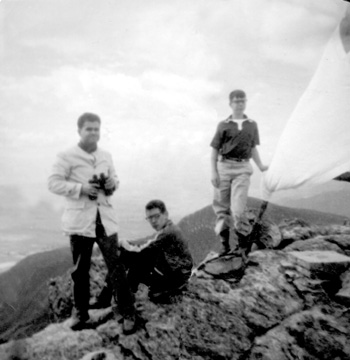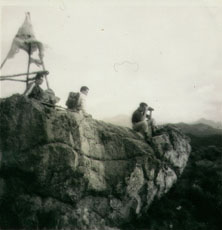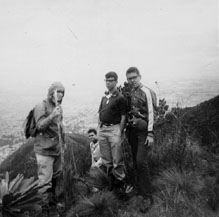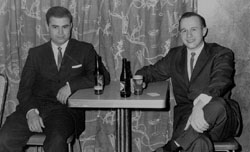
"American Embassy, Bogota, Colombia," the bulletin board announcement indicates next to my name. When I read the list on the board I'm a little disappointed. "South America just isn't what I had in mind. It's the wrong continent..." I say to myself. My only question is, "Where in the hell is Bogota, Colombia, anyway?" The propeller military flight departs from Charleston, South Carolina, and takes over nine hours to carry me only as far as Panama. After a brief spell in Panama I quickly dislike the tropical climate. Panama's hot and humid during the summer months and hot and humid with lots of rain during the rainy season are unbearable. Ecologically, the country is filled with jungles, insects, animals and microbes. Panama City on the Atlantic is a hustle and bustle commercial hub while Colon on the Pacific side is small, inert and peaceful. Our embassy people arrange my transportation to Colombia. An old, clanky DC-3 is the U.S. Army mission aircraft. It's usually used for flying supplies and provisions from Panama to Colombia for the American contingent.In it I arrive at Bogota. After a few weeks in Colombia, I began to comprehend the significance of this country in the region. For one thing Colombia fringes with Panama in the north. Also, Colombia fringes on both the Pacific and Atlantic Oceans. A significant historical/political factor, as I will learn later, is that Panama was part of Colombia before the Panama Canal was finished. There are many implications in all this.
Then there's that infernal banditry and bloody violence in the countryside. Newspapers daily publish stories with ugly pictures of massacres of entire villages and school buses full of children. The notorious so-called bandits butcher without mercy. They're known for what is called "leave-no-seed" killings in which the fetuses of pregnant are killed separately from the already dead pregnant woman. Then there's the "neck tie" procedure in which a person's throat is cut then the tongue pulled out through the slit in the throat. It's said that these killers are hit men once hired by politicians to eliminate the competition now left with nothing to do. I guess the most notable social aspect
is the two-tier society, the top and the bottom, no middle. Colombians
are either extremely rich or Colombia has a serious shortage of trees in some areas near Bogota. With the help of American and Colombian Boy Scouts we planted about 500 saplings in one day. The "forest" is dedicated by U.S. Ambassador Fulton Freeman to the city. A most lucrative trade seems to be emeralds. The highest quality emeralds are traded and sold at national banks and stores. Since they are so much less expensive in Colombia than they are in the United States, an ongoing smuggling industry exists. Smugglers can be most anyone traveling to the U.S. Everyone from company VIPs to students and company representatives smuggle Colombian emeralds into the U.S.
I'd read stories about Inca gold being hidden and often discarded by the population when they learned the Spanish conquistadores were coming their way. Their gold could have been hidden in caves, buried underground, dumped into lakes and perhaps even dumped into snow water pools along mountain slopes. In my quest for adventure I concentrate on Inca gold. On my hikes I carry only the most meager equipment: my goggles, swim fins and snorkel. The only body protection I have against the elements are sweat clothes. This is no match for the water temperature that was often below 50 degrees. The water was crystal clear but so cold that I could remain the pools only seconds at a time. I would take about 4 or 5 plunge dives. My body numbed and ached each time when barely beneath the surface. I've never found any traces of Inca gold or anything else archaeological for that matter in any of those pools. I also dive in a not too distant volcanic lake. It too is very icy cold. I don't find anything there either. I never lose my enthusiasm or willingness to go back for more, however. Just the effort of diving to see if there's something there seems worthwhile enough. The natural scenery and wildlife habitats
of Colombia are spectacular. At the higher altitudes above Bogota My quest for Inca gold proved to be a great adventure of the spirit. The real treasures I found were discoveries of various aspects and features of the country and its people I'd never imagined. There are so many contrasts, contradictions and wonders. I couldn't have received a better assignment. |
Back to Main Page
 Only
a few weeks ago I was in Fox Company scrambling to complete embassy
security training. At graduation in May 1961, I've asked for
assignment to anywhere in Europe. As you would have it, I'm not
the shining star of the class so I have to accept whatever spot
is given me.
Only
a few weeks ago I was in Fox Company scrambling to complete embassy
security training. At graduation in May 1961, I've asked for
assignment to anywhere in Europe. As you would have it, I'm not
the shining star of the class so I have to accept whatever spot
is given me. One of the first
things I observe when moving about Bogota is the constant earthquake
activity. Before coming to Colombia I'd never experienced an
earthquake. My first encounter occurs as I lay flat on my back
on a sofa in the living room of a 6th floor apartment in downtown
Bogota. I began to sense a creepy deep vibration, a low decibel
rhythmic thud, as if someone were pounding the apartment wall
with the back of their fist. Then jolts began to shake the furniture.
The chandelier over my head sways back and forth. I know what
is happening but I don't panic. I remain calm on the sofa. My
friend comments serenely, "This happens every day here..."
One of the first
things I observe when moving about Bogota is the constant earthquake
activity. Before coming to Colombia I'd never experienced an
earthquake. My first encounter occurs as I lay flat on my back
on a sofa in the living room of a 6th floor apartment in downtown
Bogota. I began to sense a creepy deep vibration, a low decibel
rhythmic thud, as if someone were pounding the apartment wall
with the back of their fist. Then jolts began to shake the furniture.
The chandelier over my head sways back and forth. I know what
is happening but I don't panic. I remain calm on the sofa. My
friend comments serenely, "This happens every day here..." extremely
poor. The cost of living is very low for an average-wage American
but very high for locals who have nothing. A working class exists
but on a most minute scale. Many members of the work force are
foreigners. Foreigners tend to colonize, living and socializing
primarily within themselves.
extremely
poor. The cost of living is very low for an average-wage American
but very high for locals who have nothing. A working class exists
but on a most minute scale. Many members of the work force are
foreigners. Foreigners tend to colonize, living and socializing
primarily within themselves. I waste no time in
learning about the country and its intricacies. Bogota is located
at about 8500 above sea level in a plateau flanked by Andean
peaks. As such, hiking and trekking attracts me and often I go
alone. The risk is great considering the roving hordes of killers
and terrorists on horseback who wreak havoc on the villages close
to the capitol. Yet, I never consider this risk. I've never yet
came upon any scenes of violence.
I waste no time in
learning about the country and its intricacies. Bogota is located
at about 8500 above sea level in a plateau flanked by Andean
peaks. As such, hiking and trekking attracts me and often I go
alone. The risk is great considering the roving hordes of killers
and terrorists on horseback who wreak havoc on the villages close
to the capitol. Yet, I never consider this risk. I've never yet
came upon any scenes of violence. vegetation thins and at elevations below
Bogota foliage becomes thicker and greener. When hiking these
mountains I often came across small groups or family clans of
indians living in small shelters fashioned from tree branches.
These structures appeared to be their permanent homes. They cook
and chat as they sit in a circle around their campfire. These
settings remind of the hunter-gatherer indigents of old. These
people notice me and look my way as I walk past at a distance.
They don't greet and I'm not sure whether I should either. These
indigent people are likely descendants of the original Inca clans
that once populated this land during pre-Columbian times.
vegetation thins and at elevations below
Bogota foliage becomes thicker and greener. When hiking these
mountains I often came across small groups or family clans of
indians living in small shelters fashioned from tree branches.
These structures appeared to be their permanent homes. They cook
and chat as they sit in a circle around their campfire. These
settings remind of the hunter-gatherer indigents of old. These
people notice me and look my way as I walk past at a distance.
They don't greet and I'm not sure whether I should either. These
indigent people are likely descendants of the original Inca clans
that once populated this land during pre-Columbian times.